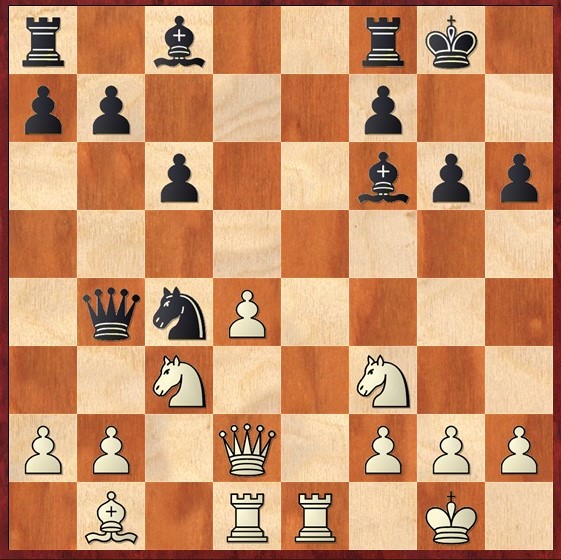The first thing I want to write is a very important and interesting topic: intermediate move in chess.
During the game we have a lot of possibilities of getting an intermediate move, but automatically we miss the improvement of our position and sometimes a win.
An intermediate move— it's a move which can appear in a forcing line, combination or in an exchange of pieces with a mission to get a better position.
An intermediate move of the opponent can:
- break your advanced calculations ,
- change your planned moves in the game,
- influence on the estimation of the forcing line,
- call disprove of the combination.
This move mostly continues with a check (intermediate check) or with an attack on a stronger piece. It can happen on any stage of the game: opening, middlegame, endgame.
First we'll analyse an example from my game.
This game was played on the 8 round of the International chess tournament in Serbia. Nearly half of the game I had to defend my position, but in the ending my opponent lost all of his advantage and made a final mistake.
Was played 60.b5?? , offering the exchange of pawns
Tuna, A - Ambartsumova, K. Palic Open 03.11.16
But white offering the exchange of pawns made the rook temporarily be out of the game and the black could use it!
But acting automatically and accepting the draw I exchanged pawns on b5, gave a check on d3 with my rook,and then took the pawn on a3 forced to an equal endgame. 60...ab 61.Rb5 Rd3 62.Kg2 Ra3=
Meanwhile, the result of the game in black's favor decided a few intermediate moves, previous the exchange on b5.
60...g4+!
First intermediate check forced white to move back with the king. 61.Kg2 Rd2+! - second intermediate check! Now white's king has to move back even more, and white's rook will not have time to help the king to stop the black's g pass pawn.
If the white answer 62.Kg1, then black will make another intermediate move 62...Kg3!
63.Kf1, and then another intermediate move 63...Kf3! 64. Ke1 Re2 65. Kd1 to push back the king of the opponent. And only now black exchanges the pawn on b5, opening the rook from a5. But the rook can not help: 65... ab 66. Rb5 Ra2 and black's g pawn becomes a queen.
If white would have answered 62.Kf1, then 62...ab 63. Rb5 Kh3!! -+ Occurred theoretically winning position for black, showing on the next diagram.
White doesn't have time to put the king in front of the pass pawn, also black's pass pawn passed to the demarcation line and white can not stop the pawn.
If white tries to protect first rank and come back with King to g1: 64. Rb1, then black prevents it so 64...Kh2! 65. Rb4 Rg2 66. a4 Rg1+ 67. Ke2 g3 -+ and the pawn can be promoted.
On check 64. Rh5+, black will answer 64...Kg3 65. a4 Rf2+! 66. Kg1 Ra2 67. Kf1 Rxa4 to win a pawn on a4 the only hope of white to hold the game. Arise theoretical winning endgame 68. Rg5 Ra1+ 69. Ke2 Rg1 70. Rg8 Kh2 71. Rh8+ Kg2 72. Rh7 g3, where black is winning.
In this way black had a real chances to win the game due to intermediate moves.
Now let's look at the games of the great chess players.
Fischer - Spassky. World Chess Championship 1972.
White did mistake had played last move 21.Bb5? he was counting on 21...Qb2 he will have the capture on c6 22.Bc6 bc 23.Qc6 . But the game continues 22.Bc6 Nc3! (intermediate move!)
This move forced white to exchange the queens 23.Qb4 Qb4 24.ab bc and black has a pawn up in the endgame. But few moves later black miss another intermediate move as well. Black had to give back the pawn and the game ended in a draw: 25. Be5 Nb5 26.Rc1 Rc8 27.Nd4 f6?
White should not take on b5 immediately, he has 28.Bf6!(intermediate move). The game followed: 28...Bd4 29.Bd4 Nd4 ed и.т.д. 1/2
Now let's look at the game of World Champion Magnus Carlsen.
Carlsen - Topalov Nanjing, 2010
Black did a last move 31...Ne5, to attack the Queen. But White should not move Queen and can do few intermediate moves to sacrifice Queen and to get good compensation for it 32. de! Nd3 33.ef Kf8 34.Bh6 Ke7 35. feQ Ke8 36.Bd3, then black lost Knight on h7 as well. White won the game.
Now let's try to solve some puzzles.
One of the earliest game with using of this tactiс.
Lichtenhein - Morphy. New York, 1875.
Kramnik - Lautier. Tilburg, 1998
Karjakin - Carlsen. New York, 2016
You can leave your answers in the comments.













